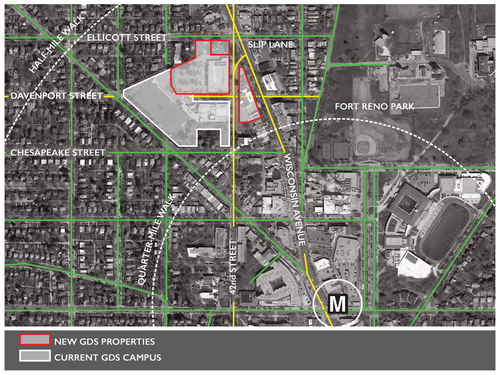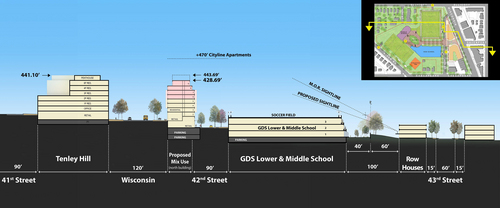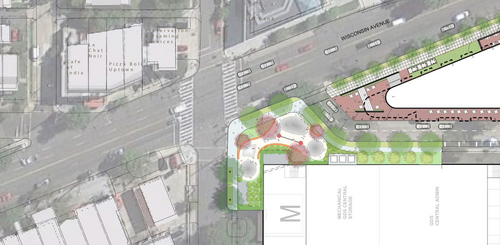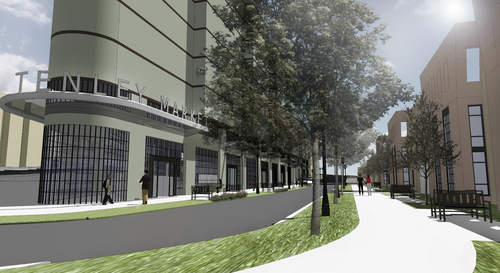A private school’s plan could totally revamp public space in Tenleytown
A private school in Tenleytown has big plans for its property. The scheme could kick off revitalization of Wisconsin Avenue north of that area’s Metro stop.
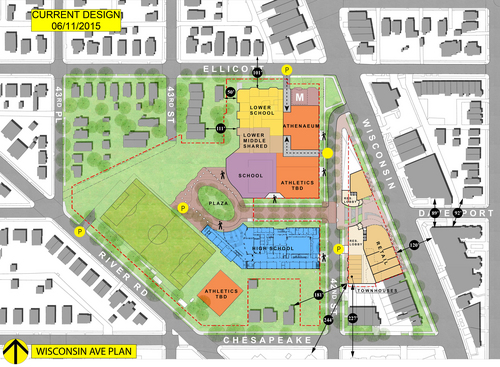
Plan of the Georgetown Day School’s proposal at Wisconsin Avenue’s elevation. Click to enlarge. Image from GDS/Esocoff & Associates.
In 2013, the Georgetown Day School surprised everyone by announcing that it had purchased two major sites adjacent to its 42nd Street NW upper school: a suburban Safeway store and a triangular parcel that currently hosts a car dealership.
The Safeway had been the site of three hotly-debated redevelopment proposals. The Martens car dealership lots, too were candidates for a large residential development. Many neighbors worried that if GDS built a large, closed-off campus, it would squash efforts to make Wisconsin Avenue a walkable corridor with neighborhood-serving retail.
Instead, the school may end up creating the most vibrant streets in Tenleytown. What the school has revealed could be the seed of a more diverse, livelier neighborhood.
The proposal has a lot going for it: it’s an ideal use of the District’s planned unit development system (PUD), it’s got a strong architectural voice leading the way, and it has the beginnings of excellent urban design.
School and city meet at 42nd Street
GDS’s upper school will remain where it is, south of Davenport Street and west of 42nd. The middle and lower schools will move into a large three-story building, topped with an athletic field. They will share the building with facilities for athletics, the arts, and the whole school community.

Plan of the GDS proposal at 42nd Street elevation. Click to enlarge. Image from GDS/Esocoff & Associates.
Next to its current underground gym, GDS will add an athletics building on lots that it purchased separately. The current plan replaces parking lots to the north of Davenport with a wide green buffer and either exercise courts or a learning garden. It will create a very nice campus for the school, especially if the design breaks up the large school building.
Across 42nd Street is where the neighborhood has a big opportunity. On the long, triangular dealership parcel, GDS will build two nine-story buildings, similar to the ones that line Connecticut Avenue. GDS is doing this to shore up its financial endowment, but the surrounding community will benefit from what’s happening as well.
While nine stories still counts as low-rise, it’s still higher than the parcel’s current zoning will allow. GDS is using the Planned Unit Development process, which allows them to combine all of the development rights for the site. By building less than is ordinarily permitted on the school site, they can shift that density onto Wisconsin Avenue, the area’s major corridor. This re-balancing of zoning to tailor a large project to its neighborhood is exactly what PUDs were created to do.
The narrow parcel sits where Wisconsin abruptly climbs a hill into Tenleytown. There is a nearly two-story grade difference from north to south and east to west. The plan handles this difference elegantly: small, neighborhood-style retail spaces face Wisconsin Avenue. A larger anchor store will sit under those shops, facing 42nd Street.
The two buildings will house around 350 apartments, including six built-in townhouses fronting 42nd street. Because of the grade change, residential lobbies will sit on the second floor on 42nd street. Like bay windows, they can be generous and private while facing a busy street. The lobbies both sit off of a short pedestrian street that fully separates the two buildings.
The public space is most important part
That gap between the buildings is why this project seems particularly promising to me. It connects the two existing segments of Davenport street with a small pedestrian-plaza and a dramatic flight of stairs. Davenport was never built here, but the result is a long block and a missing connection. Without the steps, the climb is just one long slog.
The new passage will make that length into two shorter, friendlier blocks, with a place to linger when going up and down the hills. And visitors at Fort Reno Park, DC’s highest spot, will get a view of Virginia that’s tightly framed from ground to sky.
There are three other ways the project will shape public space. One is a small triangle parcel at Ellicott Street. This will be created by closing a slip lane between Wisconsin and 42nd Street. There, landscape architects Lemon|Brooke are considering a number of options for the space, including a small plaza, a playground, and a demonstration garden.
The plan also proposes reconfiguring 42nd Street as a friendly side street. The northern residential building will occupy a sliver of the right-of-way, and parking spots would yield space for bigger sidewalks. The new school building will supplant the bunker-like Safeway and WMATA chiller plant. The schools’s main meeting space, dubbed the “Athenaeum,” may open onto 42nd Street as well.
The final way the project will define public space is the tapered end of the north building. It’s the only flatiron lot north of Cathedral Commons. By its sheer visibility, it would be a landmark on Wisconsin Avenue. If done right, its slender proportions could echo the towers that are Tenleytown’s most famous features.
This project has an experienced architect
The aesthetics of such a large project are very important. Fortunately, GDS has a good architect partner in Esocoff and Associates. Esocoff designs in a refined postmodernist style. He’s best known for five brightly colored, curved brick buildings built on Massachusetts Avenue in the last decade.
Esocoff has a big body of work beyond that, including the original GDS upper school on Davenport. Back in the late 80s, 42nd Street was basically a back alley. So, that building turns its back on the neighborhood. In an interview, he said it was now time to do the opposite: the whole precinct could be a vibrant anchor for the north end of Tenleytown.
In the 1970s, when Esocoff studied architecture at the University of Pennsylvania, his teachers obsessed over how buildings fit into the city. They imagined every part of a building as a fragment of something at the next larger scale. The biggest scale was a city.
He told me “the whole area should seems seamless, like it’s inevitable,” but that individual buildings “should feel as surprising as they are inevitable.” I think it’s possible to see that in the way Davenport Plaza splits off from Wisconsin Avenue in a big, broad arc.
He hasn’t pinned down an aesthetic yet. He said it probably wouldn’t look like Mass Ave. Instead, he pointed to Kalorama, where his office is currently working on the old Chinese embassy. It’s an apt example. Like Tenleytown, Kalorama is very green and hilly. It’s also much denser.
The community can be a partner in shaping how Tenleytown grows
Excellent design lets a corridor of nine story buildings sit comfortably next to large houses. Similarly, there’s a lovely, pedestrian-only flight of stairs. It’s rich fabric shows what happens when one generation gives thoughtful density to those that follow.
Honestly, in GDS’s proposal, there’s just nothing worth saying “no” to. The challenge for the community is to work with the design team to refine the proposal. Through the PUD process, the school has opened a dialogue. There’s a risk the ANC could go down the rabbit hole getting concessions from the developer without a focus.
Instead, they’d serve the community best by doubling down and insisting that GDS get the basic elements of walkable urban design right: adaptable public spaces, permeable facades, pedestrian connectivity, and memorable architecture.
If they push the design for those criteria, the design will naturally develop a character suiting Tenleytown’s history and geography. But more importantly, it will be a part of a thriving urban environment.

